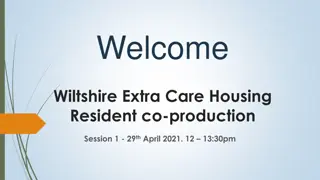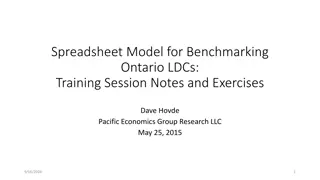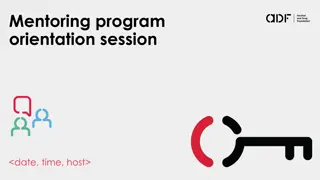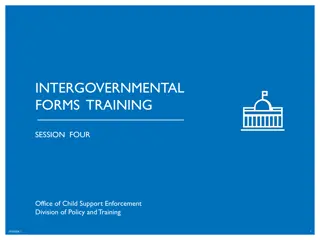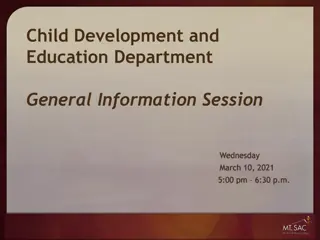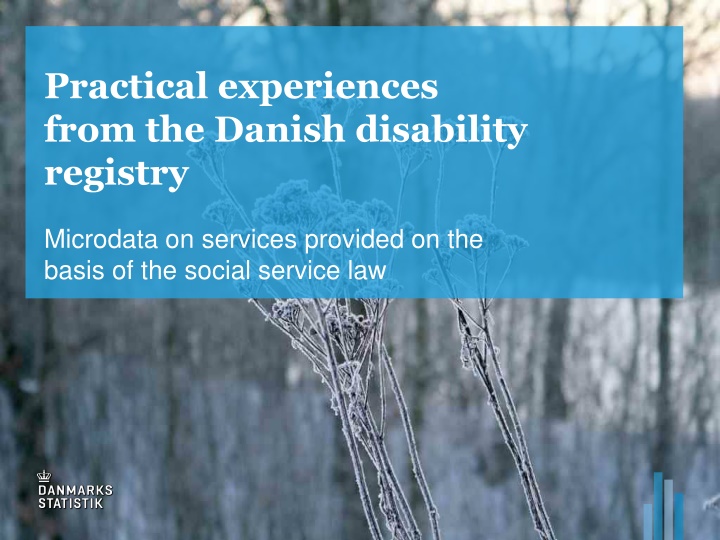
Analyzing Practical Experiences with Danish Disability Services
This information provides insights into the Danish disability registry, focusing on services provided under the social service law. It covers core concepts, longitudinal data, examples, and the legal framework governing social services. The data allows for analytical perspectives on services provided, recipients, providers, and outcomes like changes in income and employment status. Controversial design decisions regarding disability definitions and target groups are also discussed, showcasing how individual services are mapped to legal paragraphs.
Download Presentation

Please find below an Image/Link to download the presentation.
The content on the website is provided AS IS for your information and personal use only. It may not be sold, licensed, or shared on other websites without obtaining consent from the author. If you encounter any issues during the download, it is possible that the publisher has removed the file from their server.
You are allowed to download the files provided on this website for personal or commercial use, subject to the condition that they are used lawfully. All files are the property of their respective owners.
The content on the website is provided AS IS for your information and personal use only. It may not be sold, licensed, or shared on other websites without obtaining consent from the author.
E N D
Presentation Transcript
Practical experiences from the Danish disability registry Microdata on services provided on the basis of the social service law
Three core concepts A service An actual service provided to an individual citizen, such as a specific instance of pedagogical support. A service provider A specific nursing home or rehabilitation center. A target group The category of disability that forms the basis of the municipality s decision to award a specific service to a citizen. 2
The data Longitudinal data on individuals and services In principal, for all services which have been active since 2013-07-01 Every service has basic background information, information about the service provider and information about the target group. All service types map to paragraphs in the law on social services. 3
The law on social services Describes the obligations of municipalities with regard to their citizens including their disabled citizens. Some requirements are specific, others less so. 107 and 108 describe the municipalities obligation to provide long and short term residence with appropriate support. 85 describes the obligation of the municipality to provide help, care and support as well as training for individuals with significant disability or particular social problems. 5
Controversial design decisions Disability definitions based on service law Target groups based on VUM specifications Basic unit is services and not individuals No primary target group 6
Analytical perspective Sample size = N and the personal ID number enables unique research opportunities Input measures 1. What services were provided 2. To whom 3. By whom 4. On what basis Input measures Outcome measures 1. Changes in income 2. Changes in employment status 3. Educational attainment 4. etc . Outcome measures 7
Example outcome measure Individuals between 16-64 years old receiving some kind of disability service. Categorized by public benefit status. 7 8 2 4 79 Supported employment Unemployment and pension Passive benefits No public benefits Training and education 8
Future perspectives on data about service providers The data in principle allows us to identify the specific service provider delivering a service. IT providers and municipalities are struggling to deliver this data The national registry of service providers is still undergoing quality checks In 2016, better quality is expected New possibilities More information about the contents of services More information about the price of services 9
Target groups occurence Target groups are not, by definition, indicative of a medical diagnosis. By far the largest groups are cognitive disabilities and psychiatric disabilities. 10
Data coverage The first publication in May 2015 contained data from 13 municipalities Some data has arrived from close to 70 municipalities this is available to researchers More than double the initial publication size is expected for the next publication in December 2015 13
Why is it hard to deliver data? There were two assumptions about data that were made on the basis of an initial consultant report. 1. All municipalities would store their data in some systematic way, as they all have to provide services according to the same rules. 2. The providers of the IT system would relatively easily be able to extract the information in a standardized way. Turns out : They didn't and they weren't. 14
Data available to scientific community All microdata is available on DST servers Data is categorized for quality Available for foreign researchers through accredited Danish institutions 15
Improving data Constant communication with municipalities Municipalities must verify their own data Updating the specifications as new issues arise Extensive error-checking using statistical and logical models 16
Number of services vary greatly Number of activity and social support services per thousand citizens in selected municipalities 7 6 5 4 3 2 1 0 17
Questions? Contact: ogd@dst.dk +45 39 17 31 09



